| کد مقاله | کد نشریه | سال انتشار | مقاله انگلیسی | نسخه تمام متن |
|---|---|---|---|---|
| 1754823 | 1522810 | 2015 | 16 صفحه PDF | دانلود رایگان |
عنوان انگلیسی مقاله ISI
Dolomitization process and its implications for porosity development in dolostones: A case study from the Lower Triassic Feixianguan Formation, Jiannan area, Eastern Sichuan Basin, China
دانلود مقاله + سفارش ترجمه
دانلود مقاله ISI انگلیسی
رایگان برای ایرانیان
موضوعات مرتبط
مهندسی و علوم پایه
علوم زمین و سیارات
زمین شناسی اقتصادی
پیش نمایش صفحه اول مقاله

چکیده انگلیسی
High-quality reservoirs in the third member of Lower Triassic Feixianguan Formation in the Jiannan area are exclusively restricted to dolostone, which makes it essential to understand origin of porosity in dolostone. However, the studies on the porosity origin of the dolostone in the Jiannan area are rare, and its origin is still controversial. In the paper, the formation mechanisms of porosity in replacement dolostones ever proposed worldwide are summarized, and they can be divided into two main categories based on the formation time of porosity relative to the dolomitization process: syndolomitization and postdolomitization origin. Studies on well cores that have been dolomitized to varying degrees indicate that the porosity in dolostones in the Jiannan area is a syndolomitization origin which is intimately associated with the dolomitization process, depending mainly on the degrees of dolomitization. Four stages of porosity evolution, each with distinctive petrographic and petrophysical properties, were distinguished. In initial stage of dolomitization (stage I), dolomite was formed mainly by volume for volume replacement with porosity constant or slight decrease due to external carbonate source added. In the next stages of progressive dolomitization (stage II), only minor intercrystalline pores were developed and the porosity slightly increased. In more advanced stage (stage III), abundant intercrystalline, as well as some vuggy pores, were formed by selectively dissolution of residual microcrystalline calcites and micritized grains, and the porosity remarkably increased with increasing dolomite content. In the most advanced stage (stage IV), dolomite cements were precipitated in pre-exiting pores in dolostone, resulting in varying decrease in porosity and permeability. Carbonates that must proceed at least in the stage III have the high porosity, while the dolostones in the stage II-2 that display similar rock frameworks only have a minor increase in porosity.
ناشر
Database: Elsevier - ScienceDirect (ساینس دایرکت)
Journal: Journal of Petroleum Science and Engineering - Volume 131, July 2015, Pages 184-199
Journal: Journal of Petroleum Science and Engineering - Volume 131, July 2015, Pages 184-199
نویسندگان
Guangwei Wang, Pingping Li, Fang Hao, Huayao Zou, Xinya Yu,